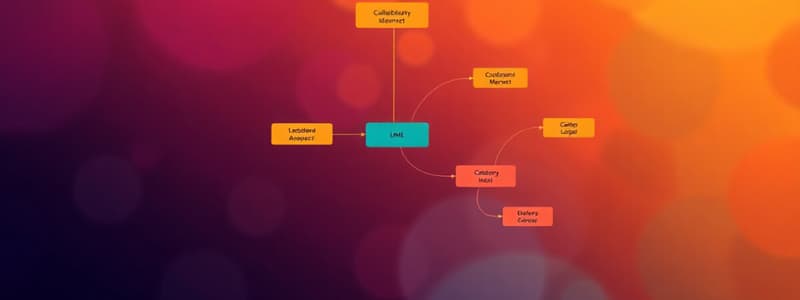Podcast
Questions and Answers
What primary purpose does UML serve in the field of software engineering?
What primary purpose does UML serve in the field of software engineering?
- To act as a database management system.
- To function as an operating system.
- To serve as a compiler for various programming languages.
- To provide a general-purpose, graphical modeling language. (correct)
Which of the following describes the role of UML diagrams in system development?
Which of the following describes the role of UML diagrams in system development?
- They are used solely for generating code
- They are used for project management.
- They are implemented to describe, analyze, discover and test system features. (correct)
- They serve as a replacement for programming languages.
Who were the primary developers of UML in the mid-1990s?
Who were the primary developers of UML in the mid-1990s?
- Dennis Ritchie, Ken Thompson, and Brian Kernighan
- Bill Gates, Steve Jobs and Steve Wozniak
- Guido van Rossum, James Gosling, and Bjarne Stroustrup
- Grady Booch, Ivar Jacobson, and James Rumbaugh (correct)
When was UML adopted as a standard by the Object Management Group (OMG)?
When was UML adopted as a standard by the Object Management Group (OMG)?
Which of the following is NOT a goal of UML?
Which of the following is NOT a goal of UML?
What characteristic of UML allows users to develop and exchange meaningful system models?
What characteristic of UML allows users to develop and exchange meaningful system models?
How does UML support the integration of best practices in software development?
How does UML support the integration of best practices in software development?
Which of the following best describes UML's relationship to object-oriented analysis and design?
Which of the following best describes UML's relationship to object-oriented analysis and design?
In what way does UML contribute to system development, regarding the workflow?
In what way does UML contribute to system development, regarding the workflow?
What is a significant characteristic of UML in terms of its representation of system models?
What is a significant characteristic of UML in terms of its representation of system models?
Which of the following is NOT one of the three primary building blocks of UML?
Which of the following is NOT one of the three primary building blocks of UML?
How do the building blocks of UML contribute to creating a complete UML model diagram?
How do the building blocks of UML contribute to creating a complete UML model diagram?
Which category of 'things' in UML is responsible for describing the static behavior and physical components of a model?
Which category of 'things' in UML is responsible for describing the static behavior and physical components of a model?
Which of the following UML structural things represents a set of identical objects, defining their functionality and properties?
Which of the following UML structural things represents a set of identical objects, defining their functionality and properties?
How is an 'Object' represented differently from a 'Class' in UML notation?
How is an 'Object' represented differently from a 'Class' in UML notation?
What does an 'Interface' represent in the context of UML?
What does an 'Interface' represent in the context of UML?
In UML, how is a 'Collaboration' symbolized?
In UML, how is a 'Collaboration' symbolized?
What core concept of object-oriented modeling is represented by a 'Use Case'?
What core concept of object-oriented modeling is represented by a 'Use Case'?
Which UML element represents an object that interacts with the system, typically under use case diagrams?
Which UML element represents an object that interacts with the system, typically under use case diagrams?
What does a 'Node' represent in UML?
What does a 'Node' represent in UML?
What is the primary focus of 'Behavioral Things' in UML models?
What is the primary focus of 'Behavioral Things' in UML models?
Which of the following is considered a primary kind of 'Behavioral Thing' in UML?
Which of the following is considered a primary kind of 'Behavioral Thing' in UML?
In UML, what does an 'Interaction' comprise?
In UML, what does an 'Interaction' comprise?
How is a message typically rendered graphically in a UML interaction diagram?
How is a message typically rendered graphically in a UML interaction diagram?
What does a 'State Machine' specify in UML?
What does a 'State Machine' specify in UML?
In a UML state machine diagram, what does a transition represent?
In a UML state machine diagram, what does a transition represent?
What is the focus of an 'Activity' in UML, compared to an 'Interaction' or 'State Machine'?
What is the focus of an 'Activity' in UML, compared to an 'Interaction' or 'State Machine'?
What is a 'package' in UML?
What is a 'package' in UML?
In UML, what is the purpose of 'Annotational Things'?
In UML, what is the purpose of 'Annotational Things'?
Which UML element is used for rendering constraints and comments attached to an element?
Which UML element is used for rendering constraints and comments attached to an element?
What is illustrated by 'Relationships' in UML?
What is illustrated by 'Relationships' in UML?
Which type of UML relationship indicates that a change to one model element may affect the semantics of another element?
Which type of UML relationship indicates that a change to one model element may affect the semantics of another element?
In UML, what does an 'Association' represent?
In UML, what does an 'Association' represent?
What kind of relationship is 'Aggregation' in UML?
What kind of relationship is 'Aggregation' in UML?
In a generalization relationship, what does the child element inherit from the parent element?
In a generalization relationship, what does the child element inherit from the parent element?
What does a 'Realization' relationship signify in UML?
What does a 'Realization' relationship signify in UML?
Which type of UML diagram is most suitable for visualizing the flow of actions that a user performs to achieve a goal?
Which type of UML diagram is most suitable for visualizing the flow of actions that a user performs to achieve a goal?
In a Use Case diagram, what does an actor represent?
In a Use Case diagram, what does an actor represent?
What is one of the main advantages of using Use Cases?
What is one of the main advantages of using Use Cases?
Flashcards
What is UML?
What is UML?
A general-purpose, graphical modeling language used in Software Engineering.
Purpose of UML diagrams?
Purpose of UML diagrams?
Describe, analyze, discover, and test a system's characteristics and behaviors.
Primary goal of UML?
Primary goal of UML?
To provide a ready-to-use, expressive visual modeling language.
Characteristic of UML?
Characteristic of UML?
Signup and view all the flashcards
Main UML building blocks?
Main UML building blocks?
Signup and view all the flashcards
Structural Things in UML?
Structural Things in UML?
Signup and view all the flashcards
Behavioral Things in UML?
Behavioral Things in UML?
Signup and view all the flashcards
What is a Package in UML?
What is a Package in UML?
Signup and view all the flashcards
Annotational Thing in UML?
Annotational Thing in UML?
Signup and view all the flashcards
Describe Relationships in UML
Describe Relationships in UML
Signup and view all the flashcards
What is Dependency?
What is Dependency?
Signup and view all the flashcards
What is Association?
What is Association?
Signup and view all the flashcards
What is Generalization?
What is Generalization?
Signup and view all the flashcards
What is Realization?
What is Realization?
Signup and view all the flashcards
What are use cases?
What are use cases?
Signup and view all the flashcards
Advantages of Use Cases?
Advantages of Use Cases?
Signup and view all the flashcards
What are UML actors?
What are UML actors?
Signup and view all the flashcards
Study Notes
Introduction to UML
- UML stands for Unified Modeling Language
- It is a general-purpose graphical modeling language used in software engineering
- UML diagrams are used to describe, analyze, discover, and test a system's characteristics and behaviors
- UML was initially developed by Grady Booch, Ivar Jacobson, and James Rumbaugh in 1994-95 at Rational Software
- In 1997, UML was adopted as a standard by the Object Management Group
Goals of UML
- UML aims to provide users with an expressive, ready-to-use visual modeling language for model development and exchange
- It offers extensibility and specialization mechanisms to expand core concepts
- UML is designed to be independent of specific programming languages and development processes
- A goal is to provide a formal basis for understanding the modeling language
- UML supports higher-level development concepts like collaborations, frameworks, patterns, and components
- Integration of best practices is a key goal
Characteristics of UML
- UML is a generalized modeling language
- It is distinct from programming languages like C++ and Python
- UML is interrelated with object-oriented analysis and design
- It is used to visualize the workflow of a system
- UML is pictorial, generating powerful modeling artifacts
UML Building Blocks
- UML consists of three main building blocks: things, relationships, and diagrams
- Building blocks are combined to generate a UML model diagram
- The basic UML building blocks are things, relationships, and diagrams
Things
- Things are the most important building blocks in UML
- They can be structural, behavioral, grouping, or annotational
Structural Things
- Structural things depict the static behavior and display physical and conceptual components of a model
- Include classes, objects, interfaces, nodes, collaborations, components, and use cases
- Class: A class outlines the functionality and properties of identical things
Objects and Interfaces
- Object: An object describes the behavior and functions of a system
- Its notation is similar to a class, but the object name is underlined
- Interface: An interface is a set of operations that describes the functionality of a class
Collaboration and Use Case
- Collaboration: Represents the interaction between things to meet a goal and is drawn as a dotted ellipse
- Use case: It portrays a set of actions executed by a system to achieve a goal
Actor, Component and Node
- Actor: Found in use case diagrams and interacts with the system
- Component: Represents the physical part of the system
- Node: Represents a physical element that exists at run time
Behavioral Things
- Behavioral things represent the dynamic parts of UML models
- There are three primary types of behavioral things: interaction, state machine, and activity
Interaction
- Interaction is a behavior that comprises a set of messages exchanged among a set of objects or roles within a specific context for a specific purpose
- The behavior of a society of objects or individual operation may be specified with an interaction
- An interaction involves messages, actions, and connectors between objects, represented graphically as a directed line including the operation name
State Machine
- State machine specifies the sequences of states an object or interaction goes through during its lifetime in response to events
- It includes states, transitions (flow from state to state), events (triggering transitions), and activities (responses to transitions)
- A state is graphically represented as a rounded rectangle, including its name and substates
Activity
- Activity specifies the sequence of steps a computational process performs
- Interactions focus on the set of objects interacting
- State machines focus on the lifecycle of one object at a time
- Activities focus on the flows between steps, regardless of which object performs each step
- An action is a step of an activity
- Actions are rendered as rounded rectangles with the purpose of the action specified
- States and actions are distinguished by their context
Grouping and Annotational Things
- Grouping things bind the elements of the UML model together
- Packages are the primary grouping thing, serving as a general-purpose mechanism for organizing design
- Packages are purely conceptual and exist only at development time
- Graphically, a package is represented as a tabbed folder, usually with only its name and content
- Annotational things are explanatory parts of UML models
- Notes are the primary annotational thing, used for constraints and comments attached to a single or collection of elements
- Notes are rendered as a rectangle with a dog-eared corner and textual or graphical comments
Relationships
- Relationships illustrate meaningful connections between things, show associations between entities, and define application functionality
- The four types of relationships include dependency, association, generalization, and realization
Dependency, Association
- Dependency: A semantic relationship where a change to one model element can affect another. Graphically, it is a dashed line, possibly directed
- Association: A structural relationship among classes describing links or connections among objects.
Generalization, Realization
- Generalization: The specialized element (child) builds on the specification of the generalized element (parent)
- The child shares the structure and behavior of the parent. Graphically, it is a solid line with a hollow arrowhead
- Realization: A semantic relationship between classifiers, in which one classifier specifies a contract that another must carry out
- These often occur between interfaces/classes (or components) and use cases/collaborations.
- Graphically, it is a cross between generalization and dependency
Diagrams in UML
- UML includes 13 types of diagrams
Use Case Diagrams
- Use case diagrams are utilized in systems and software engineering
- They list actions or event steps, defining interactions between a role and system, for achieving goals
What are Use Cases, Actors
- A use case is a list of actions or event steps that define the interactions between a role, known as an actor in UML, and a system to achieve a goal
- The actor can be a human, an external system, or even time
- Use cases describe how a real-world actor interacts with the system
Importance of Use Cases
- Use cases have been used extensively over the past few decades
- Use cases provides a summary of system offerings, gives an overview of system component roles, and assists in defining roles and needs
- Use cases Advantages: provide a summary of system offerings, gives an overview of system component roles, and assists in defining roles and needs
Hospital Management System Use Case Diagrams
- A general use case diagram shows an Admin and a Patient
- The admin can:
- Manage Patients' Info and Status
- Manage Hospital Rooms info and Status
- Manage Hospital Transaction Records
- The diagram also shows the actors involved in Hospital system
Online Shopping System Use Case Diagrams
- Displays interactions with an online shopping system
- It has actors such as Registered Customer, New Customer, Web Customer, Authentication, Identity provider etc
Banking System Use Case Diagrams
- Displays interactions with a Banking System
- The actors are :Customer, Cashier, Bank, Manager and their use cases with inter-dependencies
Library Management System Use Case Diagrams
- It displays interactions with Library System
- The actors are: User, Students, Staff, Librarian etc with a set of options on the system
College Information System Use Case Diagrams
- Shows the basic College Management System
- Main actors: Admin, Students and employees with what they can do on the system
Practice Questions
- Common questions asked about Unified Modelling Language
Studying That Suits You
Use AI to generate personalized quizzes and flashcards to suit your learning preferences.




